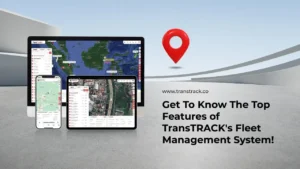Find Out What are the Advantages of Car Safety Features from TransTRACK!
Posted on July 28, 2023 by Nur Wachda Mihmidati

The car safety features encompass various technologies and systems designed to enhance the safety of drivers, passengers, and pedestrians within a vehicle. These safety features aim to reduce the risk of accidents and serious injuries while protecting individuals inside and around the car.
Functions of Car Safety Features
Car safety features serve several primary functions with the goal of safeguarding drivers, passengers, and pedestrians. Here are some of the main functions of car safety features:
Accident Prevention
Safety features are designed to assist in accident prevention by alerting drivers to potential hazards on the road. For instance, the Forward Collision Warning system provides warnings if the vehicle ahead is moving too slowly or if a collision is likely.
Crash Protection
In the event of an accident, safety features aim to protect drivers and passengers from serious injuries. Components such as airbags, seat belts, and body protection systems, such as a sturdy frame, play a crucial role in reducing the impact of a collision and safeguarding vulnerable body parts.
Enhanced Vehicle Stability
Certain safety features, such as Electronic Stability Control (ESC), help maintain the stability of the vehicle when facing potentially destabilizing situations like sharp turns or slippery road surfaces. This assists in preventing skidding or rollovers.
Improved Driver Response
Car safety features can also enhance a driver’s response and ability to drive safely. For example, the Anti-lock Braking System (ABS) allows drivers to maintain control of the vehicle during sudden braking, while driver fatigue monitoring systems help identify signs of fatigue and provide warnings for the driver to rest.
Environmental Hazard Alerts
Some safety features are designed to detect hazards surrounding the vehicle, such as Blind Spot Monitoring Systems (BSM) and Cross-Traffic Alert systems, which provide warnings if there are unseen vehicles or pedestrians.
Reduced Pedestrian Injuries
Safety features also focus on protecting pedestrians. For instance, automatic braking systems with pedestrian detection can reduce the risk of accidents by automatically activating the brakes when detecting pedestrians in front of the vehicle.
Car safety features aim to create a safer driving environment, reducing the risk of accidents and serious injuries. It is important for drivers to understand and properly utilize these features to enhance safety on the road.
[display-post-read-also]
What are the Safety Features in Cars
Here are some additional car safety features commonly found in modern cars:
Rearview Camera
A rearview camera assists the driver in seeing the area behind the car when reversing. It helps reduce the risk of accidents during parking or backward movement.
Lane Departure Warning (LDW)
This system provides a warning to the driver if the vehicle unintentionally drifts out of the lane without using the turn signal.
Lane Keeping Assist (LKA)
This feature helps keep the vehicle within its lane by providing a gentle push or warning if the vehicle starts to deviate from the lane without permission.
Adaptive Cruise Control (ACC)
This system allows the driver to automatically adjust the speed and distance from the vehicle ahead. It helps maintain a safe distance and reduces the risk of collisions from sudden stops.
Rear Cross Traffic Alert (RCTA)
This feature provides a warning to the driver when reversing from a parking spot if there are approaching vehicles or pedestrians from the sides.
Adaptive Headlights
Headlights that can adjust the beam angle depending on the steering wheel position or vehicle speed, allowing better visibility in various road conditions.
Automatic High Beams (AHB)
This system automatically controls the high beam settings when there are approaching vehicles from the opposite direction, helping to avoid glare and providing optimal visibility.
Forward Collision Warning (FCW) with Pedestrian Detection
This system alerts the driver if there is a risk of a frontal collision with a vehicle or pedestrian ahead.
Driver Drowsiness Detection
This system monitors the driver’s behavior and provides a warning if signs of drowsiness or lack of concentration are detected.
Adaptive Steering
This system adjusts the steering ratio based on the vehicle’s speed, making maneuvers more responsive at low speeds and more stable at high speeds.
Emergency Stop Signal (ESS)
This feature rapidly flashes the brake lights when the driver performs sudden braking, warning the driver behind to reduce the risk of collision.
Advanced Driver Assistance Systems (ADAS)
This is a category of car safety features that includes a combination of technologies such as Traffic Sign Recognition, Lane Centering, Park Assist, and others, designed to provide assistance to the driver and enhance overall safety.
It should be noted that each car may have a different combination of these safety features depending on the model and specifications. It is always important to read the user manual and understand how to use the safety features in your car.
TransTRACK Safety Features
The All-in-One TransTRACK platform offers a variety of solutions to assist with your fleet operations. This time, TransTRACK’s Fleet Telematics Solution will explain some of the key safety features that can be used within your fleet.
DMS (Driver Monitoring System)
The dashboard’s DMS camera provides alerts if the driver is smoking, using a cellphone, drowsy, not paying attention to the road, or not in the driver’s seat. This helps the driver stay focused on operating the vehicle.
ADAS (Advanced Driver Assistance System)
The ADAS camera facing the road provides warnings if there are objects in front of the vehicle, if the vehicle is too close to the road shoulder, or if the vehicle in front has started moving.
Foot Sensor
The foot sensor on the gas and brake pedals provides a warning when it detects the driver sitting cross-legged or not positioned in front of the gas and brake pedals.
Obstacle Sensor
The obstacle sensor at the rear of the vehicle gives you a warning if it detects objects within the predetermined radius behind the vehicle.
Seat Belt Sensor
The seat belt sensor provides a warning if it detects the driver not wearing a seat belt while inside the vehicle cabin.
360 Camera
Installation of cameras at the front, right side, left side, and rear of the vehicle helps the driver display a 360-degree video to see blind spots around the vehicle.
E-Seal
TransTRACK’s E-Seal is an automatic cargo lock that utilizes RFID or a web application. Equipped with GPS (Global Positioning System) and notifications for any tampering with the E-Seal, it helps you address these issues and enhances security, efficiency, and reliability in the supply chain.
Driver Behavior
Monitor speed, acceleration, braking, and driver behavior on buses to enhance passenger safety and comfort.
Passenger Counting
Count the number of passengers boarding and alighting, determine the bus’s maximum capacity, and analyze passenger density on each route using door and seat utilization. This improves bus operation efficiency.
Speed Limiter
Restrict the bus’s maximum speed according to traffic regulations to reduce the risk of accidents and extend the lifespan of the vehicle’s engine.
Overspeed Sensor
Provide audible alerts to the driver when the vehicle exceeds the speed limit, improving passenger safety.
The Fleet Management System ensures easy monitoring of your vehicle’s location. Additionally, with TransTRACK’s Fleet Telematics Solution, you can also access additional features such as Driver Behaviour, Voice Monitoring, Fuel Monitoring, Speed Limiter, Driver ID, Immobilizer & Double Protect, Temperature Sensor, Door Status, and more. Prioritize safety and efficient fleet management with TransTRACK today!
Recent Post
Topic :
 Bahasa Indonesia
Bahasa Indonesia









